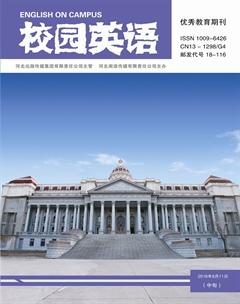An Analysis of the Translations of The Nightingale and the Rose from the Perspective of Skopos Theory
陈子婧
【Abstract】Issue of free translation and literal translation has long been focus of dispute among translators. In this paper, I want to study on how the translator can produce translation that faithful to the source text, how the translator can exercise their freedom in the constraints of faithful rule. The main theoretical model adopted in this paper is Vermeers Skopos theory. Oscar Wilde's The Nightingale and the Rose and its two Chinese versions will serve as case study data.
【Key words】The Nightingale and the Rose; Oscar Wilde; Ba Jin; Su, Fuzhong& Zhang Min; Skopos Theory
1. Vermeers Skopos theory
“Skopos is a Greek word for 'purpose', and Skopostheorie is called by Vermeer a theory of purposeful action”(Nord 1997a: 12). In Skopos theory, it is not the source text, but the skopos of translation which determines the overall translation action.
2. Oscar Wilde's The Nightingale and the Rose and its two Chinese versions
Oscar Wilde, born in 1854, stands out as dramatist, novelist, and poet. He became known for his involvement in the Aesthetic movement. The Nightingale and the Rose is a moving story about self-sacrifice and love.
Wilde's fairy tales were translated into Chinese by Ba Jin in 1949, Su Fuzhou & Zhang Min in 1999. Ba praised the literary charm of the original work and wants to introduce it into China, but the target reader of his version is mainly adults. Su and Zhangs translation is children-oriented, their objective is to re-produce the beauty in the source text and to amuse the target reader.
3. Analysis of The Nightingale and Rose
1) But there is no red rose in my garden, so I shall sit lonely, and she will pass me by. (Wilde 2009: 26, 28)
可是我的园子里并没有红玫瑰,我就不得不寂寞地枯坐在那儿,她会走过我面前不理我。(Ba 2007: 15)
可是我的花园里没有红玫瑰,那我只好孤零零坐在那里,眼睁睁看她从我身边走过去。(Su & Zhang 2009: 29)
Throughout the two translations, Ba tends to use more literary, standard language; Su and Zhang tend to use more vivid, vernacular language. In example 1, Ba translate lonely into “寂寞”, while Su and Zhang translate into “孤零零”. Moreover, Su and Zhang add “眼睁睁” in other half of the sentence to attend mutual context rhetorical effects.
2) So the nightingale sang to the Oak-tree, and her voice was like water bubbling from a silver jar. (Wilde 2009: 34)
夜莺便唱歌给橡树听,她的声音好像银罐子里沸腾着的水声一样。(Ba 2007: 18)
于是,夜莺给圣栎树唱歌儿,她的声音好像水从银壶里泻出来那样叮咚作响。(Su & Zhang 2009: 35)
Rather than describe the how the sound like, Su and Zhang use onomatopoeic words to imitate the real sound that the text describe. Taking “bubbling” in example 2 as an example, Ba translate it as “沸腾” which is totally faithful translation. While Su and Zhang free translate the whole phrase “bubbling from a silver jar” into “从银壶里泻出来那样叮咚作响”. Although Ba is more faithful than Su and Zhang, I personally prefer Su and Zhangs version. As we know, for many children, they firstly get to know fairy tales not from reading, but from hearing. For those children, lexical relate to sound are very important, it can produce lively, colorful image for them.
4. Conclusion
Through the analysis of the two translations of The Nightingale and the Rose, I figure out that Su and Zhangs version is more suitable for children to read. All three translator mainly applied domestication strategy in their translation to make the translations fluent and comprehensible. The difference of two translations is: Ba tends to use more literary, standard language; Su and Zhang tend to use more vivid, vernacular language. Furthermore, Su and Zhang use more onomatopoeia and interjection in their translation. Thus, although Bas version is also faithful to the source text, Su and Zhangs version attain the same function with more lively language.
The Nightingale and the Rose is a fairy tale that Wilde specially written for children. Addressee is the most important factor that determines the skopos of a translation. Thus, translator should center on target reader. Although Bas translation also faithful to the literary meaning of source text, his intend reader is mainly adults and his skopos is not compatible with the original authors intention. Su and Zhang center on young target reader and produce translation that faithful to the authors intend meaning.
References:
[1]Ba,Jin.(Trans.)(2007).KuaileWangziJi[The Happy Prince and Other Tales].Shanghai:Shanghai Translation Publishing House.
[2]Su,Fuzhong& Zhang Min.(Trans.)(1999).XingfuWangzi[The Happy Prince and Other Tales].Beijing:The External Translation Press of China.
[3]Vermeer,H.J.(1989).Skopos and Commission in Translational Action.Amsterdam:Benjamins.
[4]Wilde,Oscar.Su,Fuzhong& Zhang Min.(Trans.)(2009).The Happy Prince and Other Tales.Beijing:The External Translation Press of China.

